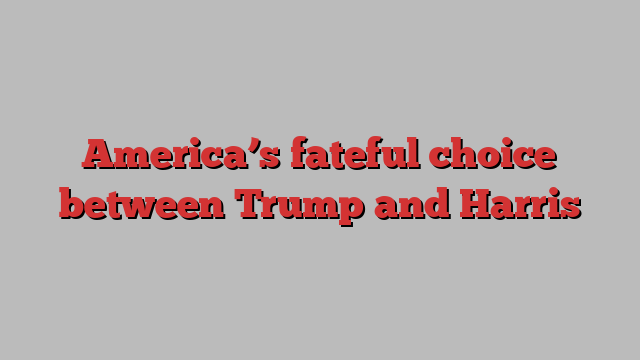
Unlock the US Election Countdown newsletter for free
The stories that matter on money and politics in the race for the White House
Donald Trump was asked in May whether this year’s election would end in violence. “It depends,” was his reply. That so many Americans distrust their voting system is mostly down to the former president. In the nearly 250 years since the US declaration of independence, the republic’s most precious quality has been its peaceful transfer of power. Trump’s 2024 campaign is based explicitly on his repudiation of Joe Biden’s 2020 victory. In his mind, the verdict on that “stolen election” will be delivered on Tuesday.
In case there was any doubt, Trump has vowed that his first act as president would be to pardon the “patriots” jailed for the January 6 assault he incited on the Capitol. He reminds voters at every rally that he plans to punish those he blames for his 2020 defeat.
His opponent Kamala Harris this week compared the “hit list” with which Trump would enter office with her own “to do list”. Harris is far from a perfect candidate. Since entering the contest late after President Joe Biden’s withdrawal, she has struggled to define herself in her own terms. In a race where the economy leads voter concerns, her remedies seem at best half-baked. But Americans need not like what is on Harris’s to-do list to see that this is no apple-to-apple comparison. This is an election in which one candidate accepts the US constitutional order. The other wants to overturn it.
An astonishingly large number of Americans are nevertheless unmoved, by Trump’s attack on democratic norms. But there are also strong conventional reasons to question the risks of a new Trump presidency. These include his radical plans for the US and international economy, his impact on global stability and his disregard for the rule of law both at home and abroad.
Trump’s economic programme amounts to a rejection of America’s postwar global role. He would slap 20 per cent tariffs on all imports and at least 60 per cent on goods from China. Contrary to what Trump asserts, tariffs are not a tax on foreign companies. Their cost would largely be borne by the US consumer through higher prices. Launching a global trade war would trigger retaliation by America’s friends and foes alike. The IMF reckons such a shift would lop a percentage point off next year’s US growth and cut global expansion by a quarter. The price of escalating trade barriers would only get steeper in 2026.
Trump also wants to curb the US Federal Reserve’s independence and people around him suggest he would replace its chair Jay Powell a year before his term ends. There is no near-term rival to the US dollar as the world’s reserve currency — though there is rising demand for an alternative, as last week’s Russia-hosted Brics summit conveyed. Politicising the Fed, vandalising what remains of global trade rules and expelling millions of undocumented migrants are the kind of game-changers that could trigger a rapid shift from the dollar.
Like good health, the upsides to having the reserve currency would be appreciated only when they are gone. Prospects for blue collar America would also be grim. Rising inflation leads to higher interest rates and lower growth. There would be no middle class boom in Trump 2.0. His wealthiest donors should also be clear eyed about any bargains they have struck. The short-term upside to lower capital gains tax and preferential regulatory treatment must be weighed against the cost of radical uncertainty. They could no longer take for granted the system that made them rich.
Much the same benefits apply to America’s network of alliances. The destabilising effects of the US turning against the global order it created would be dynamic. Trump is hostile to Nato and friendly to Russia’s Vladimir Putin. His consistent admiration for the Kremlin strongman bodes badly for Ukraine, which Trump has made clear he will push into a lopsided settlement with Moscow.
The Trump effect on China is less predictable. He would be as likely to strike a deal with Xi Jinping as to target full US-China decoupling. The only given about Trump’s approach to the Indo-Pacific is his allergy to alliances. Countries such as Japan, South Korea and Australia would be forced to hedge against the withdrawal of the US security umbrella. Nations of all sizes could also abandon hope of further US involvement in collective action against global warming. America First is also America Alone. The autocrats’ “alliance of the aggrieved” would rush to fill any vacuum left by a receding US. The world would be much less safe for democracy.
In contrast to the upheavals promised by Trump, Harris represents business as usual. Her comparatively traditional platform may appear unexciting, but it has several notable merits. Her advocacy for legislation that would enshrine reproductive rights nationwide would guarantee women the freedom to make decisions about their own bodies. The non-partisan Committee for a Responsible Federal Budget estimates the Harris programme would raise the ballooning US federal debt by only half that of Trump’s. The switch to renewable energy, a central plank of her agenda, would be a service to America and the world.
People also tend to undervalue stability. Less important than the detail of Harris’s programme is what she stands for implicitly. Where Trump threatens a perilous rupture, Harris represents continuity with the values of liberal democracy and free and open trade — the bedrock of prosperity for America and its partners. The US electorate is on the cusp of a decision that could mark the country, and the world, for decades. There is still time to pause, take a breath and think through the consequences.